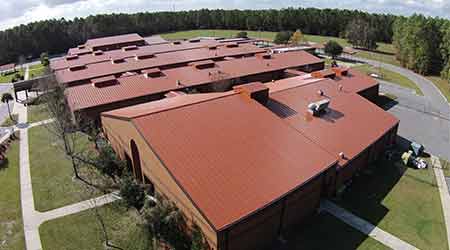 in 2015 the Camden County (Ga.) School System opted to cover the existing standing seam metal roofs on two of its elementary schools with PVC systems.
in 2015 the Camden County (Ga.) School System opted to cover the existing standing seam metal roofs on two of its elementary schools with PVC systems.Roofing: School District Replaces Aging Systems
Georgia school district overcomes schedule and weather challenges to deliver successful roofing projects.
Part one of a three part series.
Facility retrofits are rarely easy projects for maintenance and engineering managers. Success depends on specifying and coordinating the delivery of a host of materials, equipment and tools, as well as ensuring the presence of enough qualified labor to complete the job — on or under budget, ideally. As if that were not enough, managers overseeing exterior projects also need to deal with inevitable problems caused by the weather. Mike Blackerby, director of operations with the Camden County (Ga.) School System, understands that challenge all too well.
“We’re in the extreme corner of Southeast Georgia near the (Atlantic) ocean and just north of the Florida state line,” Blackerby says. “We have continual afternoon thundershowers that pop up very quickly. It’s pretty much a guarantee that every afternoon in late May through September, you’re going to have a thundershower. Combine that with the high humidity, it makes the roofing business down here a little tricky.”
Blackerby faced twice the challenge when he and his department undertook two roof retrofit projects at two of the district’s schools in 2015. The projects challenged both his planning skills and his patience.
Dealing with aging
The Camden County School System, with an enrollment of 9,054 students, is made up of 12 schools containing about 1.5 million square feet. The district needed to expand quickly with the arrival of the Naval Submarine Base Kings Bay in the mid-1980s.
“Shortly after that time, we had a boom in population associated with the navy,” Blackerby says. “As a result, we built a lot of new schools. From 1987 or so through the mid-’90s, we were building about a school a year. Now, they’ve all started to come of age in terms of needing some of these major renovations and repairs.”
The district built Mary Lee Clark Elementary School in 1987 and Matilda Harris Elementary in 1989. Fast-forward 28 years, and Blackerby and his staff faced growing maintenance challenges.
“While there were no catastrophic failures in the existing roofs, they were both beginning to show their age, and we were have periodic issues with leaking,” he says. “The roofs were well beyond their warranty years. So anything that did cause an issue we had to address by paying for it to be done, which eats into the budget because we didn’t have any warranty left on the roofs.
“From an aesthetics standpoint, these two roofs didn’t have any problems. But on some of the standing seam metal and on some of the flat portions of the roofs, we did have some leak issues — nagging, ongoing problems with leaking. We have some extreme heat in the summer, and we do have some cold days, so there’s a lot of shrinking and expanding of roofing materials. Over time, whether it’s the seams or the fasteners, they begin to show wear, and we get leaks.”
In considering product options for the schools’ deteriorating roof systems, Blackerby revisited a similar project that the district had completed two years earlier at Woodbine Elementary School.
“Woodbine was having a lot of leakage issues, and when we put (a new roof) on that school, we liked the installation process,” he says. “We had a few kinks because it was new to us, but once we fixed those, the project went smoothly. We gave the roof a year, which is not a long time in the roofing world, to see how it reacted and performed. It had no issues, so we began the process of placing it on the other two schools.”
Blackerby also had another issue to factor into the specification and planning for the 2015 retrofit projects.
“We also wanted to try to replace that roof without pulling the existing roof off,” Blackerby says. ”It’s disruptive, and if we can do anything without pulling the roof off the building, it’s going to save us in the long run.”
Related Topics:




















